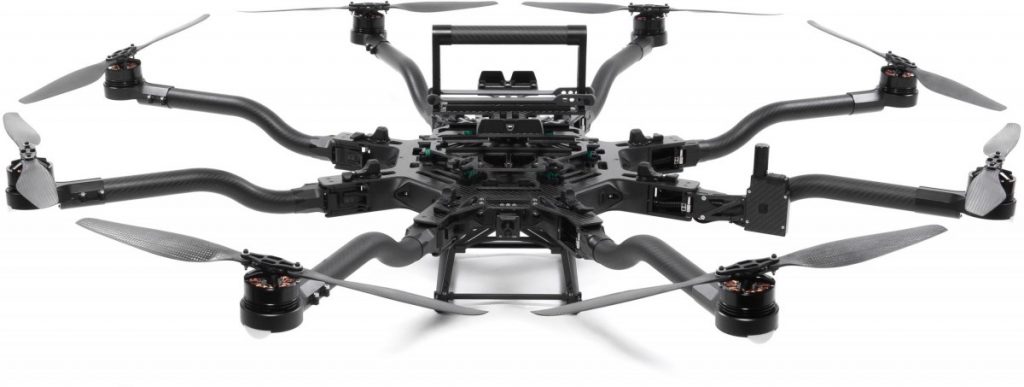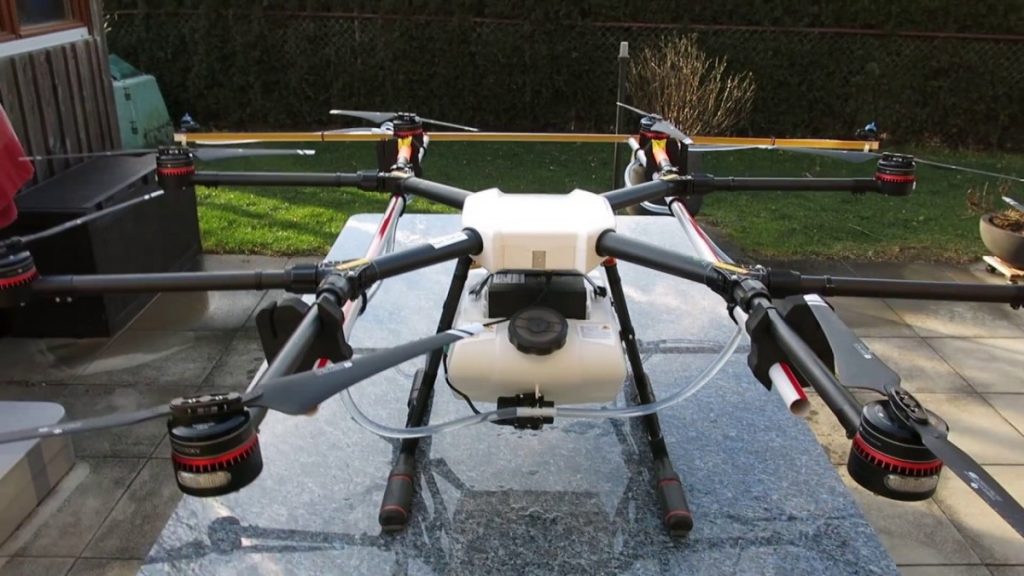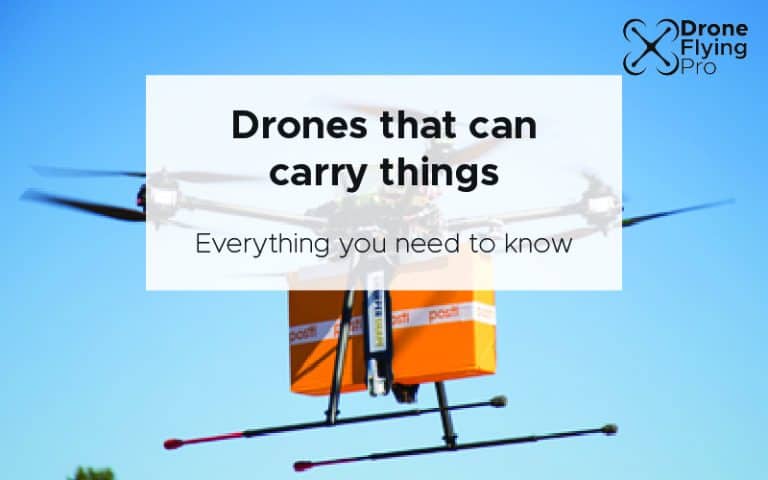Sending a drone into the sky is an exciting activity. Many times I have sent my drone up just because I wanted to get some flying time in! But drones can be used for so much more than fun! As the price of advanced drone technology goes down and scientists and engineers push the limits of what is possible with tiny motors – well see more and more drones that are able to lift heavier and heavier things. Here, let’s look at drones that can carry things and what the future looks like for them.
There are a number of drones that can carry things. The most popular on the market at the moment are the DJI Spreading wings and DJI Agras MG-1 that can carry up to 11 kgs each. But the maximum that a commercial drone can carry at the moment is 18kg that feat is performed by the is the Freefly Systems ALTA 8. Things will improve rapidly and scientists and engineers are always pushing the limits of what is possible. Top Flight Technologies have developed a gas/electric hybrid that can carry and fly for more than 2 and a half hours! Other than that, the startup is quietly developing a 100-kilowatt hybrid drone that can lift 100 kilograms — enough to carry a human or two — for up to three hours. The future for heavy listing drones looks exciting!
When you want a drone to lift heavy things you need to increase the lifting power and upwards thrust that the drone can achieve. There are a few ways that you can do that:
- Increase the number of propellers
- Increase the battery capacity
- Increase the power of the motors and size of the propellers
- Change the fuel type (gasoline/electric hybrids)
Each change and addition to the drone causes it’s weight to increase and therefore it uses more energy (either electric or otherwise) to stay in the air. As technology improves and the battery’s get more energy dense we’ll see more and more drones that are capable of lifting heavy things.
But what drones are on the market right now and that sort of weights can they lift?
Drones that can carry things
Here are a list of the commercially available drones that currently exist on the market.
DJI Matrice 600 Pro

This DJI drone is one of the leaders in heavy listing drones. This drone is primarily used for carrying a camera and gimbals for professional photography and industrial applications. It can carry up to 6 Kg and hover for 16 minutes with a max speed of 40 mph / 65 kph with no wind.
There’s no better drone if you need something to carry a large camera for high resolution imagery. However, if you need the drone to carry heavier things check out the other drones in this list!
Freefly Systems ALTA 8

This drone is one of the most advanced camera drones on the market. It has 8 motors that can carry up to 12.0 kg or 26.4 lbs. It can fold down to 50% of its size which makes it perfect for carrying to remote filming locations in a smaller carrying case. Interestingly, this drone can carry things underneath – like me see a with most drones – but it can also carry a camera on top so that it can shoot upwards towards the sky – that’s pretty cool if you ask me!
Okay, we’ve covered the best camera carrying drones but what else is on the market and what does it carry?
DJI Agras MG-1

The DJI Agras MG-1 is a drone with 8 propellers designed for spraying liquid pesticides, fertilizers, and herbicides. The drone is designed to bring new levels of efficiency to farmers that need to regularly spray their crops.
The DJI MG-1 ‘s powerful propulsion system allows the aircraft to carry up to 10 kg liquid payloads for spraying on to crops. The combination of speed and power means that an area of 4,000-6,000 m² can be covered in just 10 minutes, or 40 to 60 times faster than manual spraying operations. The intelligent spraying system automatically adjusts its spray according to the flying speed so that an even spray is always applied.
PD6B-AW-ARM (concept drone)
This drone from Pro Drone. Is an interesting concept model as it has two large arms that can be used to lift up to 20 kg or 44.1 lbs of stuff! In the video you see it grabbing to a range of different items and moving them around. Depending on the size of the object being carried (weight and volume) the drone can stay airborne anywhere between 10 – 30 minutes.
It’s an interesting concept but the market is so used to long flight times that the short flight time may be the thing that causes it to not quite grab (pun intended) hold of the market like they want to. Certainly one of the quirkier companies trying to push the limits of what drones are. Check out their website for other drone concepts that you may be seeing in the near future!
This is a selection of drones that can carry things that you could buy right now. But what does the future look like for drone carrying technology?
What science is doing to drones that can carry things?
There is a company that has been spun out from MIT called Top Flight Technologies. The specialize in providing hybrid energy power systems to drones to do two things:
- Allow drones to lift and carry heavier things
- Increase the flight times (by 10 times!)
Their unique approach to drone technology is like developing a Prius for the sky. The dual-fuel system allows the drone to fly for up to 2.5 hours while carrying a payload of about 20 pounds.
But they are not happy with just that…The startup is quietly developing a 100-kilowatt hybrid drone that can lift 100 kilograms — enough to carry a human or two — for up to three hours.
“The key is having an abundance of power and total energy. That’s what petrol and gasoline gives you. Using a high-energy-density energy source like gasoline, and converting it to electric power, and doing it efficiently, gives you the equivalent of a ‘super battery.’”
Long Phan, Top Flight Technologies
The future for heavy listing drones looks exciting and far beyond what we are able to achieve right now!
How much weight a drone can lift?
Drones vary in what they can lift as each drone has a different number of motors, motor power, battery capacity, etc. However, there are many people online that have tried to lift various items and weights with their commercial and professional drones. Here is a comparison of all of the different official, and nonofficial, weights that drones can carry.
Drone payload comparison
It can be hard to know exactly what a drone can lift in the wild vs what the manufacturer says. Here is a comparison of some of the most popular commercial drones alongside drones that are manufactured to lift heavy things! You’ll be surprised exactly how much some of the smaller drones can lift!
| Drone | Maximum Payload | Source of information |
|---|---|---|
| DJI Matrice 600 Pro | 6 kg | Official Website |
| Freefly Systems ALTA 8 | 12 kg | Official Website |
| DJI Agras MG-1 | 10 kg | Official Website |
| PD6B-AW-ARM | 20 kg | Official Website |
| DJI Mavic Mini | 181 g | YouTube experiment |
| DJI Mavic Air | 331 g | YouTube experiment |
| DJI Mavic 2 Pro | 531 g | YouTube experiment |
| DJI Phantom 3 | 1.1 kg | YouTube Experiment |
| DJI Phantom 4 | 1.1 kg | YouTube Experiment |
| DJI Spark | 65 g | YouTube Experiment |
| VALKYRIE HEAVY PRO | 30 kg | Official YouTube video |
Clearly, the drones that are designed to pick stuff up, like the VALKYRIE HEAVY PRO and Freefly Systems ALTA 8, can pick up the most. However, even the commercial drones like the DJI Phantom series can pick up quite a large object.
How much weight can a hobby drone carry?
A hobby drone, for the sake of this article, is anything that is commercially available and commonly used by hobbyists. Here the drones in the above table can pick up anywhere from 181 g (Mavic Mini) to 1.1 kg (DJI Phantom series).
Of course, because hobby drones are not meant to be used to carry objects the power and battery capacity would mean they have to take short trips. A lot of the experiments from above table dangle the payload from string and so the drones would be very unstable when it comes to flying in windy conditions.
I do not recommend that you use a photography drone for carrying purposes as it could damage your drone and quickly burn out the motors. The battery drain rate would also mean that your battery cycles could be reduced. Essentially,m everything is under strain when attempting to lift heavy objects.
That said, using “fir for purpose drones” means that you can carry a load of objects – including really heavy ones! Here are some of the specialized drones for carrying different things.
What can a drone carry?
As drone technology becomes more and more affordable and the batteries used to power them are able to carry more charge, we see many highly specialized drones! Drones are being used to carry a wide range of items!
DSLR cameras
Okay, let’s start with the most known drone package – a camera. Many commercial drones come with their own cameras. This allows you to quickly set up your drone and the drone software can easily keep the camera steady as all of the gimbal and stabilization is built-in.
For some drone photographers the inbuilt camera are not good enough. It could be that they need cinema level photography, intricate manual control of the shot – or they may need a very high resolution for surveying and mapping purposes. All of these would require a special camera to be mounted under a drone.
Drones that are able to carry a DSLR are:
- RAWcopter
- Freefly ALTA 8
- Matrice 600
- OFM XC870 hexacopter
- OFM-800 Hexa
- Sky Hero Spyder 6
- Intel Falcon 8 Plus
All of these cameras have their own compatibility preferences where they have worked with a specific manufacturer to ensure that their DSLR fits well in the drone. If you are planning on using your current DSLR with a drone take the time to figure our which drone fits it best!
Packages
This has been all over the new for a number of years but are we going to see drone package delivery from companies like UPS and Amazon in the near future? Or are there going to be other better drone delivery companies from start ups?
Different countries from around the world have been testing the feasibility of using drones for deliveries. Here’s a quick history of the drones that have been used to deliver packages:
- 2013 – Amazon Prime Air was announced
- 2014 – Google revealed it has been testing drones for the past two years. FedEx was testing their drone delivery services
- 2015 – Asian and UK based companies started also using drones for delivery. Ali baba delivered tea to 450 Chinese customers in selected cities.
- 2016 – Amazon made its first drone delivery using a drone in the United Kingdom. Flirtey conducted the first fully autonomous FAA-approved drone delivery in an urban setting in the U.S
- 2017 – Iceland’s largest eCommerce website initiated a drone delivery route that would shorten delivery times from 30 minutes to less than 5. They are currently still operating.
- 2018 – Boeing unveiled a prototype of a cargo drone for up to 500 lb (227 kg) payloads
- 2019 – UPS in association with Matternet started a three-year medical delivery trial in Raleigh
Although the concept of drone deliveries has been around for a long time, there are still many issues and concerns with safety and automation in densely populated cities around the world. There no doubt that it is on the way but it may just need another step-change in advancement before it becomes commonplace.
Medicine and medical devices
Speed is of absolute importance when there is a human life on the line. Drones have been touted as the technology required for rapid response in health emergencies. Drones have been used since 2014 to deliver a range of medical devices and supplies.
Loads of different medical items have been transported such as, defibrillators, medicine, emergency food, blood and pharmaceutical products, vaccines, medical samples – and the list is growing.
Food deliveries
Will drone food delivery put other delivery services out of business – maybe not right now but people are working on it!
The first ever food delivery was a taco delivery drone in the San Francisco area. Elsewhere in the world, a Free University of Berlin student project were able to use drones for pizza delivery. In 2013, as part of an advertising campaign, an independent Domino’s UK franchise tested the Domicopter. Similar flights were conducted in India and Russia, but lacked regulatory approval.
Agricultural liquid
Agriculture is a fantastic place for drone technology. There are big open fields that need monitoring and evaluation. Here are a few examples of how farmers use drones in their daily activities.
Drones can be used to create 3D maps for soil analysis. This information is really useful for planning seed planting. In a recent study, a Finnish research group created a drone and augmented reality system to acquire and view data for soil mapping. The drones were able to operate in cloudy conditions unlike satalye data. Also drones are a pretty easy and fun way to map any large surface!
The benefits of drone spraying is that the drone can adjust to the hills and ditches of a farms or paddocks geography. This results in a precise delivery of the products being sprayed onto the farm and has launched the idea of “Precision Agriculture”. This new field (pardon the pun) is discussed in this science study – Review on Application of Drone Systems in Precision Agriculture.
Firefighting equipment
Drones are being used to help fight fires by either monitoring them with thermal imaging or carrying a sprayer that is used to fight the fires from the sky!
This exciting aspect of drone usage has a number of different benefits for firefighters and emergency services. For example, when they arrive on the scene they can quickly observe the fire from every angle to plan their approach. They can also use a thermal camera to look for people and the hottest parts of the fire to attack with water. They can be fitted with spotlights to assist with visibility at night or in thick smoke! And they can also be used to carry the hose up to spray the fire from above:
Can a drone carry a person?
Lastly, lets look at whether or not a drone can carry a person?
The question here is what separates a drone from a helicopter? There re a number of startups and companies that are trying their best to make drone commuting a reality.
The Ehang 184 personal drone is about the size of a smart car and claims to be able to deliver one human (up to 260 pounds) anywhere within a 10 mile/23-minute flight time reach. That’s pretty impressive. What makes this more drone-like is that it is actually completely autonomous with passengers only giving the drone very simple guidance – the flying it does itself!
The question is – would you trust a drone-like this to deliver you to your destination safely? IT may be a while before you see things like this become a common feature of travel.




